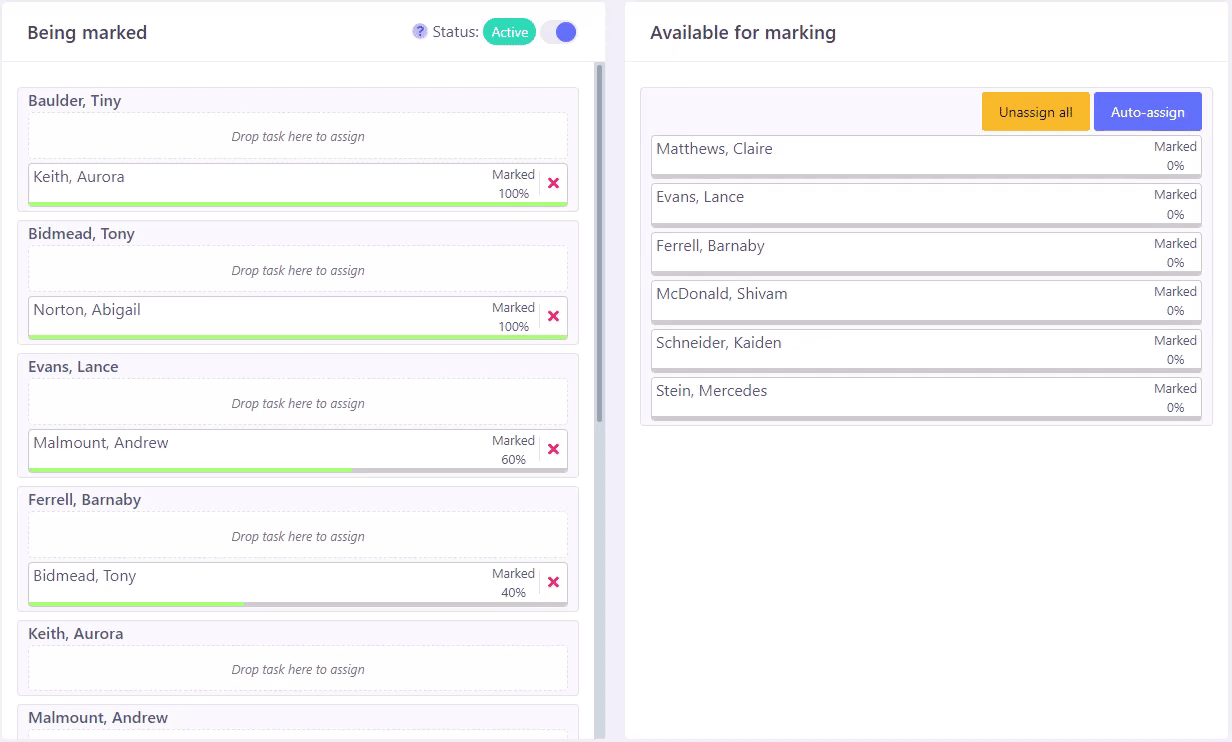Self & peer marking
Multiple choice questions are marked automatically. Longer answer questions can be marked by a teacher or AI, but they can also be marked by the student themselves or anonymously by a peer.
At face value self and peer marking can appear to be lazy teaching, but it has a very positive effect on attainment by giving students the examiner perspective.
Evaluating an answer that someone else has written against a mark scheme gives students a better understanding of how to approach their own answers.
Peer marking often works best as a class activity where the teacher controls the pace. For example, all students review the first question, tick relevant boxes of the mark scheme to indicate where marks have been awarded before saving. The teacher can address any questions from students about whether to award a mark or not. At the teacher's direction all students then navigate to the next question together.
Teacher is in control
The teacher can:
- Manually select who is marking who's work or auto-assign students to save time.
- Be part of the marking process, moderate or change marks awarded.
- See how the mark scheme was applied to each answer.
- See the progress of the peer marking process.
How it works for students
The student is never aware of who's work they are marking. They simply see the question and the mark scheme. To mark the work the student ticks the bullet points of a mark scheme that apply to the answer given and award a numerical mark. There is no option to leave written feedback unlike teacher and AI marking.
When receiving their work back, students can see the ticked mark scheme and the mark awarded, but they are unaware of who marked their work.
The research
In his latest meta-analysis published in 2023, Visible learning the sequel, John Hattie states that peer assessment has a +0.54 effect size. That means it can make a significant difference to the learning outcomes for students in addition to reducing teacher workload.
When students review the answers given by their peers they get to experience the examiner perspective. They realise how important it is to answer the question succinctly using the framework from the mark schemes.
Conversely, however, peer assessment can hinder students’ learning if poor-quality, insensitive or unhelpful peer feedback is exchanged, and may strain relationships between learners. Conducting anonymous peer review, restricting students to indicating which bullet points of the mark scheme apply to the work and choosing from a pre-determine list of feedback comments allows students to provide effective feedback without the risks.
Hattie, J. (2023). Visible learning: The sequel. Routledge
Topping KJ (2017) Peer assessment: Learning by judging and discussing the work of other learners. Interdisciplinary Education and Psychology 1(7): 1–17.
Topping KJ (2018) Learning by Peer Assessment: Appraising, Reflecting, Discussing. New York and London: Routledge.
Berg EC (1999) The effects of trained peer response on ESL students’ revision types and writing quality. Journal of Second Language Writing 8(3): 215–241.
Black P (2007) Full marks for feedback. Make the Grade (Journal of the Institute of Educational Assessors) 2: 18–21.
Kollar I and Fischer F (2010) Peer assessment as collaborative learning: A cognitive perspective. Learning and Instruction 20(4): 344–348.

Choosing peers to mark work
Feedback
With Tasks, teachers can leave written feedback for each student for the whole task or for individual questions. In addition, by enabling the MARCKS system when a task is created, students and teachers can select statements from a comment bank to indicate why full marks were not awarded for a question.
M - Maths. The student did not calculate the correct answer or show their working.
A - Application. The student did not apply their answer to the context and/or stakeholders in linked lines of reasoning.
R - Read. The student did not read the question carefully enough.
C - Communication. The student not write a clear, coherent answer and it was hard to follow.
K - Knowledge. The student did not give an accurate answer.
S - Statements. The student did not make enough statements to match the number of marks available.
A student can review the marking, including their MARCKS feedback statements against each answer. They are also presented with an overview bar chart for the whole task showing the total number of each statement indicated. Teachers can view an overview report for the whole class indicating how students need to improve their answers in future tasks.